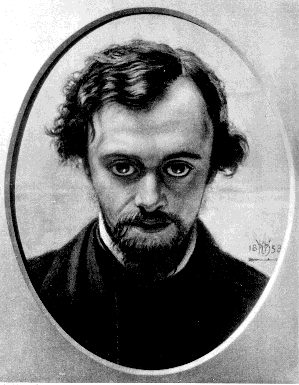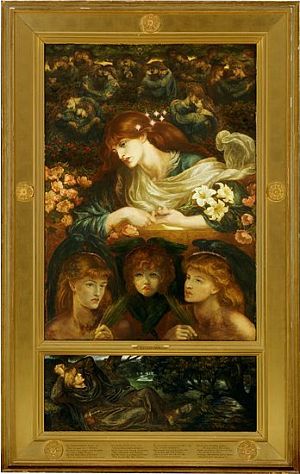DANTE GABRIEL ROSSETTI

THE BLESSED DAMOZEL
Poem Source: http://rpo.library.utoronto.ca/poem/1763.html
First publication date: February 1850

The poem and the painting I am going to compare are both
self-titled “The Blessed Damozel” by Dante Gabriel Rossetti. The poem was
published on February, 1850, and the painting was produced between 1875-8.
So, in this case, the painting can be considered as the representation
of the poem itself.
This is one of the saddest poems I have ever read. The author writes about
the story of “The Blessed Damozel”, a lady who is settled in a sort of
heaven crying and lamenting because her lover is still on Earth and she
prays God with the purpose to make her lover die thus to be able to be
together in that kind of heavenly paradise.
The poem is divided in 24 iambic stanzas (6 verses each one). The stanzas
are divided in short verses (2-4-6 of each stanza) and quite long verses
(1-3-5. Furthermore, the rhyme is: “abcbdb”, so, although, at first sight,
the rhyme and form seem arbitrary, if we observe in detail, we appreciate
that the author uses a highly regular rhyme form.
This
poem is full of images, most of them are used to express the melancholy and
sadness of the lady. For example: the fact that she is leaned over the heavenly
balcony witnessing all the souls coming up to heaven, except his lover’s
one; her eyes full of tears; the constant repetition of the time she has
been waiting (ten years)… give us the impression of the complete desperation
that the lady is suffering. However, for me, the most beautiful and representing
image of her grief in the poem and also in the painting is the visual metaphor
that she is surrounded by “happy newly met lovers” who can enjoy their endless
love as “their souls mount up to God” (Stanza 7). Besides, the author also
focuses on the enclosing elements that surround the lady: the presence of
the moon and the stars, which are used to emphasize the lady’s mood, are
useful to create the contrast between the darkness in which she is living
and the light and joy in the rest of the universe (L. 55). So we appreciate
a lady that is not only anguished because of her lover’s absence, but because
the fact that everyone is happy except her. Furthermore, another important
aspect is the fact that the author uses religious imagery to describe the
whole situation. We can read several references to Mary, God, the angels,
the Holy Spirit… which are very important to understand the real symbolization
of “The Blessed Damozel” and the meaning of the poem.
Concerning the
religious symbolism, I think that the Blessed Damozel could be interpreted
in several ways. The first one is a similitude between the lady and the
Virgin Mary. Both are merely compared several times along the poem (L. 9,
104…) But, some-how, in my opinion, the figure and position of the lady
reminds me of the figure of a martyr, or of Jesus Christ on the Cross,
praying God for the end of his pain.
The painting is a faithful
reproduction of the poem itself. It only captures one moment of the poem’s
narration, but I think, this capture represents the whole symbolic meaning
of the poem. There are several elements that appear in both of them (the
lady, the lovers behind, the three angels, the balcony, the seven stars
in her hair (the seventh one is hidden behind her head because of the visual
perspective) and the three lilies in her hand). However the painting can
also have some interpretations that are slightly different from the poem.
The first feature I have noticed is the use of colours. We can appreciate
that the green colour is patently present on any element of the picture.
I think that the author uses this colour as a symbol of life and Nature.
Truly, everything seems lively surrounding the lady, which contrasts with
her real mood. Nevertheless the use of light is contradictory. From a symbolic
point of view, the girl should be painted in darkness (if we consider dark
colours as a symbol of sadness, sorrow…) distinguishing her from the elements
that surround her that should be painted with luminous colours. However,
she is illuminated with the major ray of light and the rest of the painting
is tinted with dark tonalities of green or other colours. In my opinion,
the author allows himself this “contradiction” to make the viewers really
concentrate on the most im-portant figure of the poem and the painting, which
is the lady herself. The presence of the lover is also important (the man
in the part below of the painting) and specially his attitude. Despite the
fact that he has the hands crossed as a symbol that he is praying, his face
does not reflect excessive pain and his expression seems relaxed. From my
point of view, this aspect differentiates with the most important feature
in the painting, which is the expression of pain on the face of the girl,
where, specially her eyes show all the pain she is suffering.
In conclusion, the
poem and the painting are two splendid and beautiful representations of
the Blessed Damozel, who is condemned to a never ending suffering because
she can not enjoy her love as the rest of people do. A poem that has set
down over me a total feeling of despair, because I do not find any positive
element along the poem.
BIBLIOGRAPHY:
Dante Gabriel Rossetti. “The Blessed Damozel”. The Rossetti Archive,
Ed. Jerome J. McGann,
2nd March 2006
<(http://www.rossettiarchive.org/docs/1-1847.s244.raw.html)>
Painting source:
http://www.rossettiarchive.org/docs/s244.rap.html
THE TYGER
TO A LADY
SHE WAS A PHANTOM OF DELIGHT
VS
SHE WALKS IN BEAUTY
INDEX

